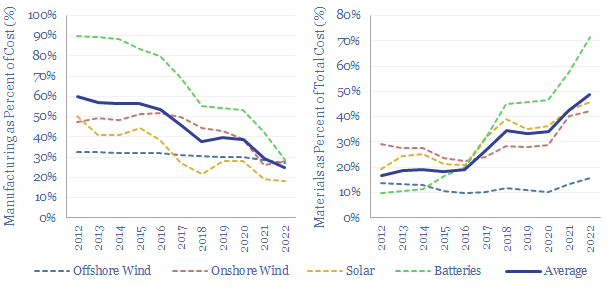Over the past decade, costs have deflated by 85% for lithium ion batteries, 75% for solar and 25% for onshore wind. Now new energies costs are entering a new era. Future costs are mainly determined by materials. Bottlenecks matter. Deflation is slower. Even higher-grade materials are needed to raise efficiency. This 14-page note explores the new age of materials, how much new energies deflation is left, and who benefits?
Over the past decade, new energies have seen remarkable deflation. Installed costs of a utility-scale solar project have fallen 75% from $4,000/kW to $1,000/kW. Lithium ion batteries have fallen by 85% from over $800/kWh to $150/kWh. Onshore wind has deflated by 20% from $1,900/kW in 2012 to $1,500/kW in 2022, although offshore wind, as an exception, has reinflated. How has this happened? And what happens from here?
The scale-up to mass manufacturing has been the largest driver of new energies deflation, reducing the manufacturing costs by up to 90% over the past decade. This is quantified on pages 2-4 for each new energies technology. However, manufacturing costs are now just c25% of total new energies costs and so future deflation must come from elsewhere.
The age of materials has arrived. For the first time, in 2022, materials were over 50% of the total installed cost of new energies, in aggregate, up from just 17% of total costs a decade ago, and mainly because manufacturing costs fell away. Our outlook for these materials and their bottlenecks are presented on pages 5-6.
Efficiency gains offer the best opportunity for further deflation. Rising efficiency lowers all cost lines. Including materials costs. This is illustrated in detail for solar. But we think the outlook for efficiency gains is very different among different new energies, per pages 7-10.
High-grading versus thrifting. A change of view in this report is that we see high-grading of materials to be more likely than thrifting. This helps improve efficiency. For example, there are routes to using 20-30% less silver in solar modules, but new HJT cells are actually using 80-100% more silver, because this helps to deliver efficiency gains that deflate all of the other cost lines. The same is true in batteries. And does this make advanced materials less commoditized and higher margin? Further examples and discussion on pages 11-12.
Which emerging new energies technologies could see more versus less deflation? Some ideas are on page 13.
Advanced materials companies for the energy transition have stood out in our research, especially as new energies enter the new age of materials. Our top ten ideas are summarized, with links to further research, on page 14.

